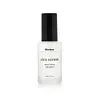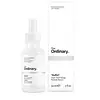Meebak Cica Serum Versus The Ordinary "Buffet"
What's inside
What's inside
 Key Ingredients
Key Ingredients

 Benefits
Benefits

 Concerns
Concerns

 Ingredients Side-by-side
Ingredients Side-by-side

Water
Skin ConditioningMethylpropanediol
SolventGlycerin
Humectant1,2-Hexanediol
Skin ConditioningCaprylic/Capric Triglyceride
MaskingNiacinamide
SmoothingDioscorea Japonica Root Extract
Skin ConditioningPolysilicone-11
Raffinose
Skin ConditioningSaccharomyces Ferment Filtrate
HumectantXanthan Gum
EmulsifyingCentella Asiatica Extract
CleansingFicus Carica Fruit Extract
HumectantDiphenyl Dimethicone
EmollientTriethylhexanoin
MaskingMadecassoside
AntioxidantPolyquaternium-51
Skin ConditioningAloe Barbadensis Leaf Water
MaskingEthylhexylglycerin
Skin ConditioningParfum
MaskingOryza Sativa Extract
AbsorbentPiper Methysticum Leaf/Root/Stem Extract
Skin ConditioningAlgae Extract
EmollientEclipta Prostrata Leaf Extract
Skin ConditioningPanax Ginseng Berry Extract
Skin ConditioningMonascus Extract
Skin ConditioningGlycosyl Trehalose
Emulsion StabilisingHydrogenated Starch Hydrolysate
HumectantAdenosine
Skin ConditioningBiosaccharide Gum-1
HumectantPolyglyceryl-10 Myristate
Skin ConditioningHydrogenated Lecithin
EmulsifyingDisodium EDTA
Laureth-12
EmulsifyingLecithin
EmollientSodium Hyaluronate
HumectantDipropylene Glycol
HumectantArgania Spinosa Kernel Oil
EmollientCamellia Japonica Seed Oil
EmollientCamellia Sinensis Seed Oil
HumectantHelianthus Annuus Seed Oil
EmollientMacadamia Integrifolia Seed Oil
Skin ConditioningOlea Europaea Fruit Oil
MaskingSimmondsia Chinensis Seed Oil
EmollientBeta-Glucan
Skin ConditioningButyrospermum Parkii Butter
Skin ConditioningTocopherol
AntioxidantCeramide NP
Skin ConditioningFructooligosaccharides
HumectantPropylene Glycol
HumectantHydrolyzed Hyaluronic Acid
HumectantHydrogenated Phosphatidylcholine
EmulsifyingRetinol
Skin ConditioningCholesterol
EmollientCetyl Alcohol
EmollientStearyl Alcohol
EmollientCarbomer
Emulsion StabilisingAmmonium Acryloyldimethyltaurate/Vp Copolymer
Tromethamine
BufferingWater, Methylpropanediol, Glycerin, 1,2-Hexanediol, Caprylic/Capric Triglyceride, Niacinamide, Dioscorea Japonica Root Extract, Polysilicone-11, Raffinose, Saccharomyces Ferment Filtrate, Xanthan Gum, Centella Asiatica Extract, Ficus Carica Fruit Extract, Diphenyl Dimethicone, Triethylhexanoin, Madecassoside, Polyquaternium-51, Aloe Barbadensis Leaf Water, Ethylhexylglycerin, Parfum, Oryza Sativa Extract, Piper Methysticum Leaf/Root/Stem Extract, Algae Extract, Eclipta Prostrata Leaf Extract, Panax Ginseng Berry Extract, Monascus Extract, Glycosyl Trehalose, Hydrogenated Starch Hydrolysate, Adenosine, Biosaccharide Gum-1, Polyglyceryl-10 Myristate, Hydrogenated Lecithin, Disodium EDTA, Laureth-12, Lecithin, Sodium Hyaluronate, Dipropylene Glycol, Argania Spinosa Kernel Oil, Camellia Japonica Seed Oil, Camellia Sinensis Seed Oil, Helianthus Annuus Seed Oil, Macadamia Integrifolia Seed Oil, Olea Europaea Fruit Oil, Simmondsia Chinensis Seed Oil, Beta-Glucan, Butyrospermum Parkii Butter, Tocopherol, Ceramide NP, Fructooligosaccharides, Propylene Glycol, Hydrolyzed Hyaluronic Acid, Hydrogenated Phosphatidylcholine, Retinol, Cholesterol, Cetyl Alcohol, Stearyl Alcohol, Carbomer, Ammonium Acryloyldimethyltaurate/Vp Copolymer, Tromethamine
Water
Skin ConditioningGlycerin
HumectantLactococcus Ferment Lysate
Skin ConditioningAcetyl Hexapeptide-8
HumectantPentapeptide-18
Skin ConditioningPalmitoyl Tripeptide-1
Skin ConditioningPalmitoyl Tetrapeptide-7
Skin ConditioningPalmitoyl Tripeptide-38
Skin ConditioningDipeptide Diaminobutyroyl Benzylamide Diacetate
Skin ConditioningAcetylarginyltryptophyl Diphenylglycine
Skin ConditioningSodium Hyaluronate Crosspolymer
HumectantSodium Hyaluronate
HumectantAllantoin
Skin ConditioningGlycine
BufferingAlanine
MaskingSerine
MaskingValine
MaskingIsoleucine
Skin ConditioningProline
Skin ConditioningThreonine
Histidine
HumectantPhenylalanine
MaskingArginine
MaskingAspartic Acid
MaskingTrehalose
HumectantFructose
HumectantGlucose
HumectantMaltose
MaskingUrea
BufferingSodium PCA
HumectantPCA
HumectantSodium Lactate
BufferingCitric Acid
BufferingHydroxypropyl Cyclodextrin
MaskingSodium Chloride
MaskingSodium Hydroxide
BufferingButylene Glycol
HumectantPentylene Glycol
Skin ConditioningAcacia Senegal Gum
MaskingXanthan Gum
EmulsifyingCarbomer
Emulsion StabilisingPolysorbate 20
EmulsifyingPPG-26-Buteth-26
Skin ConditioningPEG-40 Hydrogenated Castor Oil
EmulsifyingTrisodium Ethylenediamine Disuccinate
Ethoxydiglycol
HumectantSodium Benzoate
MaskingCaprylyl Glycol
EmollientEthylhexylglycerin
Skin ConditioningPhenoxyethanol
PreservativeChlorphenesin
AntimicrobialWater, Glycerin, Lactococcus Ferment Lysate, Acetyl Hexapeptide-8, Pentapeptide-18, Palmitoyl Tripeptide-1, Palmitoyl Tetrapeptide-7, Palmitoyl Tripeptide-38, Dipeptide Diaminobutyroyl Benzylamide Diacetate, Acetylarginyltryptophyl Diphenylglycine, Sodium Hyaluronate Crosspolymer, Sodium Hyaluronate, Allantoin, Glycine, Alanine, Serine, Valine, Isoleucine, Proline, Threonine, Histidine, Phenylalanine, Arginine, Aspartic Acid, Trehalose, Fructose, Glucose, Maltose, Urea, Sodium PCA, PCA, Sodium Lactate, Citric Acid, Hydroxypropyl Cyclodextrin, Sodium Chloride, Sodium Hydroxide, Butylene Glycol, Pentylene Glycol, Acacia Senegal Gum, Xanthan Gum, Carbomer, Polysorbate 20, PPG-26-Buteth-26, PEG-40 Hydrogenated Castor Oil, Trisodium Ethylenediamine Disuccinate, Ethoxydiglycol, Sodium Benzoate, Caprylyl Glycol, Ethylhexylglycerin, Phenoxyethanol, Chlorphenesin
 Reviews
Reviews

Ingredients Explained
These ingredients are found in both products.
Ingredients higher up in an ingredient list are typically present in a larger amount.
Carbomer is a polymer of acrylic acid. Its main role is to create a gel consistency.
A high amount of carbomer can cause pilling or balling up of products. Don't worry, most products contain 1% or less of carbomer.
Ethylhexylglycerin (we can't pronounce this either) is commonly used as a preservative and skin softener. It is derived from glyceryl.
You might see Ethylhexylglycerin often paired with other preservatives such as phenoxyethanol. Ethylhexylglycerin has been found to increase the effectiveness of these other preservatives.
Glycerin is already naturally found in your skin. It helps moisturize and protect your skin.
A study from 2016 found glycerin to be more effective as a humectant than AHAs and hyaluronic acid.
As a humectant, it helps the skin stay hydrated by pulling moisture to your skin. The low molecular weight of glycerin allows it to pull moisture into the deeper layers of your skin.
Hydrated skin improves your skin barrier; Your skin barrier helps protect against irritants and bacteria.
Glycerin has also been found to have antimicrobial and antiviral properties. Due to these properties, glycerin is often used in wound and burn treatments.
In cosmetics, glycerin is usually derived from plants such as soybean or palm. However, it can also be sourced from animals, such as tallow or animal fat.
This ingredient is organic, colorless, odorless, and non-toxic.
Glycerin is the name for this ingredient in American English. British English uses Glycerol/Glycerine.
Learn more about GlycerinSodium Hyaluronate is hyaluronic acid's salt form. It is commonly derived from the sodium salt of hyaluronic acid.
Like hyaluronic acid, it is great at holding water and acts as a humectant. This makes it a great skin hydrating ingredient.
Sodium Hyaluronate is naturally occurring in our bodies and is mostly found in eye fluid and joints.
These are some other common types of Hyaluronic Acid:
Learn more about Sodium HyaluronateWater. It's the most common cosmetic ingredient of all. You'll usually see it at the top of ingredient lists, meaning that it makes up the largest part of the product.
So why is it so popular? Water most often acts as a solvent - this means that it helps dissolve other ingredients into the formulation.
You'll also recognize water as that liquid we all need to stay alive. If you see this, drink a glass of water. Stay hydrated!
Learn more about WaterXanthan gum is used as a stabilizer and thickener within cosmetic products. It helps give products a sticky, thick feeling - preventing them from being too runny.
On the technical side of things, xanthan gum is a polysaccharide - a combination consisting of multiple sugar molecules bonded together.
Xanthan gum is a pretty common and great ingredient. It is a natural, non-toxic, non-irritating ingredient that is also commonly used in food products.
Learn more about Xanthan Gum